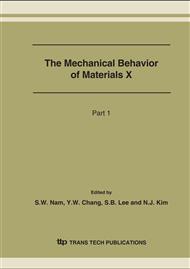p.1089
p.1093
p.1097
p.1101
p.1107
p.1115
p.1121
p.1125
p.1129
Nanoindentation Techniques: A Critical Assessment of the Current Methods of Data Analysis
Abstract:
Although instrumented indentation machines have existed since the 1950s, it is only during the past 20 years or so that there has been a very rapid rise in their use and popularity for determining mechanical properties of bulk solids, thin films and biological materials. Nowadays, machines are available with which indentation experiments are conducted automatically and the data obtained are also analyzed automatically using software, which is based on certain hypotheses and simplifying assumptions. By carrying out several series of comprehensive experiments, using rigid and elastic indenters and elastic substrates, it is shown that the current methods of nanoindentation data analysis are fundamentally flawed, which can lead to incorrect and misleading results. A new experimental approach has been suggested here, which is free from such flaws.
Info:
Periodical:
Pages:
1107-1114
Citation:
Online since:
August 2007
Authors:
Keywords:
Price:
Сopyright:
© 2007 Trans Tech Publications Ltd. All Rights Reserved
Share:
Citation:


